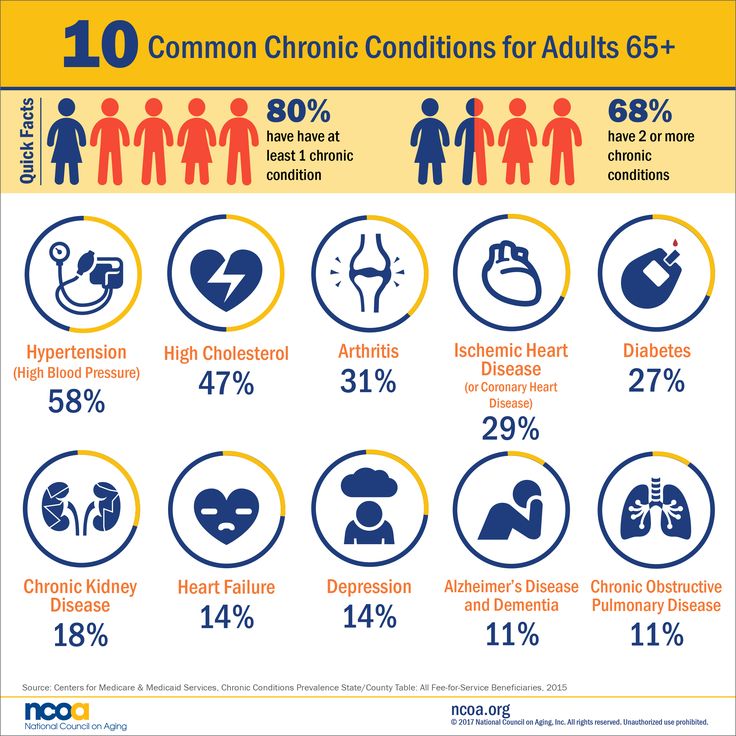
Turning 58 recently has given me a chance to reflect on what I need to understand and do to stay in good shape, both physically and mentally. I’ve been thinking about the common challenges that come with aging, and I’ve noticed that exercise, eating healthy, and avoiding stress are key to managing many chronic conditions. Here, I’m dig into the top 10 most common chronic conditions in older adults, explaining what they are and what lifestyle changes can help manage them. As we move forward, I encourage everyone to consider small, realistic steps that can make a big difference over time. It is important not only to recognize these conditions but also to adapt our daily habits so that we can continue living an active and fulfilling life.
10. Alzheimer’s Disease and Dementia
Nearly 12% of older adults on Medicare have received treatment for Alzheimer’s disease or another form of dementia. Alzheimer’s is a type of dementia that affects memory and the brain’s ability to think or solve problems. Daily activities can become difficult, and the progression of the disease can deeply affect families and caregivers. Many people find that early recognition of the symptoms can help in planning for future needs and adjusting daily routines to maintain independence for as long as possible.
Studies suggest that a few lifestyle habits may help ease Alzheimer’s symptoms. Staying active isn’t just good for your heart; it’s also great for your brain. For example, engaging in regular physical and mental exercises can help maintain cognitive function longer. Getting at least seven hours of deep sleep each night is another important factor, as your brain processes memories and repairs itself during sleep. Additionally, being thoughtful about your diet can have a positive effect: research indicates that what you eat matters. A balanced diet with plenty of vegetables, fruits, and lean proteins can help protect brain cells from damage, and incorporating omega-3 fatty acids might also step up brain health over time.
Extra attention to social connections and mental stimulation is also very important. Joining community groups, attending classes, or simply reading regularly can help keep the mind active, which is an essential part of overall wellbeing when facing conditions such as Alzheimer’s disease.
9. Depression
Depression is not a natural part of aging, even though 16% of older adults have sought treatment for it. This condition involves persistent feelings of sadness, hopelessness, and fatigue. Changes in appetite and a loss of interest in activities can also be part of the picture, making daily life feel like a heavy burden for some individuals.
It’s important to recognize that depression is treatable. Regular physical activity, a healthy diet, and stress management are common denominators in many effective treatments. Social engagement and professional help play a key role in managing depressive symptoms. Lifestyle changes, like getting outdoors, practicing relaxation techniques, or simply establishing a regular sleep routine, can ultimately help lift the mood. In addition, many find that creative projects or hobbies serve as a therapeutic outlet to express feelings and reenergize one’s passion for life. Taking the time to connect with friends or family can also help lessen the feelings of isolation often associated with depression.
8. Heart Failure
About 5% of older adults receive treatment for heart failure, a condition where the heart isn’t able to pump blood effectively to supply the organs with oxygen. Heart failure can lead to a reduced quality of life, with symptoms that may include shortness of breath, fatigue, and swelling in the legs. This condition often requires careful monitoring and adjustments to daily routines, especially when trying to maintain an active lifestyle.
Managing heart failure involves lifestyle changes such as regular exercise, following a heart-healthy diet, and avoiding excess salt intake. Careful management of stress is also helpful, as high stress levels can aggravate the condition. Working closely with your healthcare provider to monitor medication schedules and adjust lifestyle factors is essential for keeping this condition in check. In addition, patients can benefit from educational programs that provide a deeper understanding of how to recognize early warning signs and what steps to take during an emergency.
7. Chronic Kidney Disease (CKD)
Chronic kidney disease, or CKD, affects nearly 25% of older adults. CKD happens when the kidneys slowly lose their ability to filter wastes from the blood, potentially leading to serious health problems such as kidney failure or an increased risk for heart disease. The invisibility of early symptoms makes CKD particularly challenging, emphasizing the need for regular health check-ups.
Maintaining kidney health often means keeping blood pressure and blood sugar levels in a healthy range. A balanced diet that limits salt and processed foods, along with regular physical activity and stress reduction techniques, can all contribute to healthier kidneys. Patients are encouraged to schedule periodic screenings and discussions with their healthcare providers to ensure that any changes are quickly addressed. Understanding the role hydration plays in kidney function and the importance of avoiding toxins can also help slow the progression of CKD.
6. Diabetes
Diabetes affects about 27% of older adults. This disease occurs when the body either does not produce enough insulin or becomes resistant to it. Insulin is necessary for turning food into energy, and without it, high levels of blood sugar can cause damage to various organs. Because diabetes impacts multiple systems in the body, management requires a vigilant approach.
If not managed properly, diabetes may lead to complications like kidney disease, heart disease, or even blindness. A big part of managing diabetes is adopting a healthy lifestyle. Regular exercise helps improve insulin sensitivity, while a diet low in refined sugars and high in fiber can play a significant role in keeping blood sugar levels in check. In addition to these measures, staying informed about new treatment options and technologies, such as continuous glucose monitors, may provide patients with better control and a clearer picture of their daily blood sugar trends.
5. Ischemic Heart Disease (Coronary Heart Disease)
Ischemic heart disease, also known as coronary heart disease, was treated by nearly 29% of older adults. It is mainly caused by a build-up of plaque in the arteries, which restricts blood flow to the heart. This narrowing reduces the oxygen supply to heart muscles and can lead to dangerous conditions such as blood clots, angina, or even heart attacks.
Lifestyle choices play a huge role when it comes to managing heart disease. Avoiding saturated and trans fats and cutting back on sugar and salt can reduce the risk considerably. In addition to diet, getting seven to eight hours of sleep each night, keeping stress levels in check, and engaging in regular cardio exercise are all important measures. Patients are advised to quit smoking and to have open conversations with their doctors about risk factors like high cholesterol and high blood pressure. By taking charge of these factors, many people can drastically improve their heart health and overall vitality.
4. Arthritis
Arthritis affects about 35% of older adults. This condition involves inflammation in one or more joints, leading to pain, stiffness, and difficulty in moving. The impact of arthritis on daily activities can vary significantly from person to person, with some experiencing mild discomfort and others facing severe limitations in mobility.
Exercise plays a major role in managing arthritis. Regular movement helps keep joints flexible and reduces stiffness over time. Low-impact activities like walking, swimming, or cycling are particularly beneficial. Alongside physical activity, a balanced diet and methods for reducing stress have been found to ease symptoms significantly. Many people also find that incorporating gentle stretching and even practicing yoga can lead to improvements in joint mobility and overall quality of life.
3. Obesity
Obesity is another chronic condition that affects about 40% of adults aged 65 and older. Carrying excess weight is linked to numerous other health issues, including diabetes, heart disease, and arthritis. The extra strain placed on the body by obesity can significantly diminish the quality of life and limit physical activity.
Weight management is closely tied to physical activity, diet, and mental well-being. As with many of the health issues listed, regular exercise, a healthy eating plan, and effective stress management are central strategies for addressing obesity. Small changes in daily habits, such as taking the stairs instead of the elevator or opting for fruits instead of processed snacks, can lead to significant long-term improvements. Furthermore, seeking advice from nutritionists and fitness experts can provide personalized strategies to help manage weight more effectively.
2. High Cholesterol
More than 50% of older adults have been treated for high cholesterol. This condition occurs when there is an excess of harmful lipids in the blood, which can lead to the clogging of arteries and ultimately increase the risk for heart disease. Regular monitoring is very important, as high cholesterol often does not show clear symptoms until complications arise.
Managing cholesterol often involves a combination of lifestyle changes and medication when necessary. A balanced diet that limits saturated fats while encouraging the intake of fiber-rich foods from fruits, vegetables, and whole grains is frequently recommended. Regular physical activity, along with techniques to manage stress effectively, forms part of a strategy to maintain heart health and lower cholesterol levels. In addition, educational sessions on nutrition and family support groups can help individuals make more informed decisions about their overall diet and lifestyle.
1. Hypertension (High Blood Pressure)
Nearly 60% of older adults receive treatment for hypertension. This condition involves not only how hard the heart pumps but also how resistant the arteries are to that blood. High blood pressure can continue silently for years without clear symptoms yet significantly raise the risk for life-threatening complications like heart attacks and strokes.
Managing high blood pressure often starts with simple lifestyle adjustments. Regular exercise, a diet rich in fruits, vegetables, and lean proteins, and avoiding unnecessary stress are central to blood pressure control. Limiting salt intake, monitoring weight shifts, and closely following the guidance of a healthcare provider can make a huge difference. Moreover, routinely checking your blood pressure at home and at your doctor’s office assists in tracking trends and ensuring that any necessary adjustments in treatment are made promptly.
Taking Charge of Your Health
Dealing with chronic conditions can feel overwhelming at times, but I’ve found that realistic changes in everyday habits can pave the way to better health. The common thread in treating many of these conditions is clear: staying active, eating a well-balanced diet, and managing stress are vital steps toward a healthier future. Even small adjustments can have a significant impact over time.
As someone who recently turned 58, I remain extra mindful about both my physical and mental well-being. I prioritize regular exercise, balanced nutrition, and mindful relaxation techniques every day. These steps not only help in managing potential chronic conditions but also contribute to a life that is energetic and fulfilling. Over the years, I have come to appreciate the importance of routine medical guidance and regular health check-ups.
It is very important to remember that taking charge of your health is a continuous process. Regular visits to your healthcare provider, staying informed about your condition, and adopting a proactive approach to lifestyle changes can all work together to improve your quality of life. Whether it means monitoring your blood sugar, keeping an eye on your blood pressure, or simply keeping up with community activities, every step taken matters.
I hope that this detailed breakdown helps illuminate some valuable strategies for living better with chronic conditions. What are some of the healthy habits that have worked for you? I enjoy hearing about realistic ways to maintain wellness at every stage of life, and I hope this discussion encourages you to take positive steps toward a healthier future. Bottom line: small steps, consistent effort, and smart choices make a huge difference in our overall well-being.

For adults over 65 facing common chronic conditions, integrating regular exercise, a healthy diet, and stress reduction can yield significant positive impacts. These lifestyle adjustments work synergistically to improve cardiovascular health, manage weight, reduce inflammation, strengthen the body, and enhance mental well-being, offering a powerful approach to managing and potentially mitigating the progression of these age-related health challenges.

